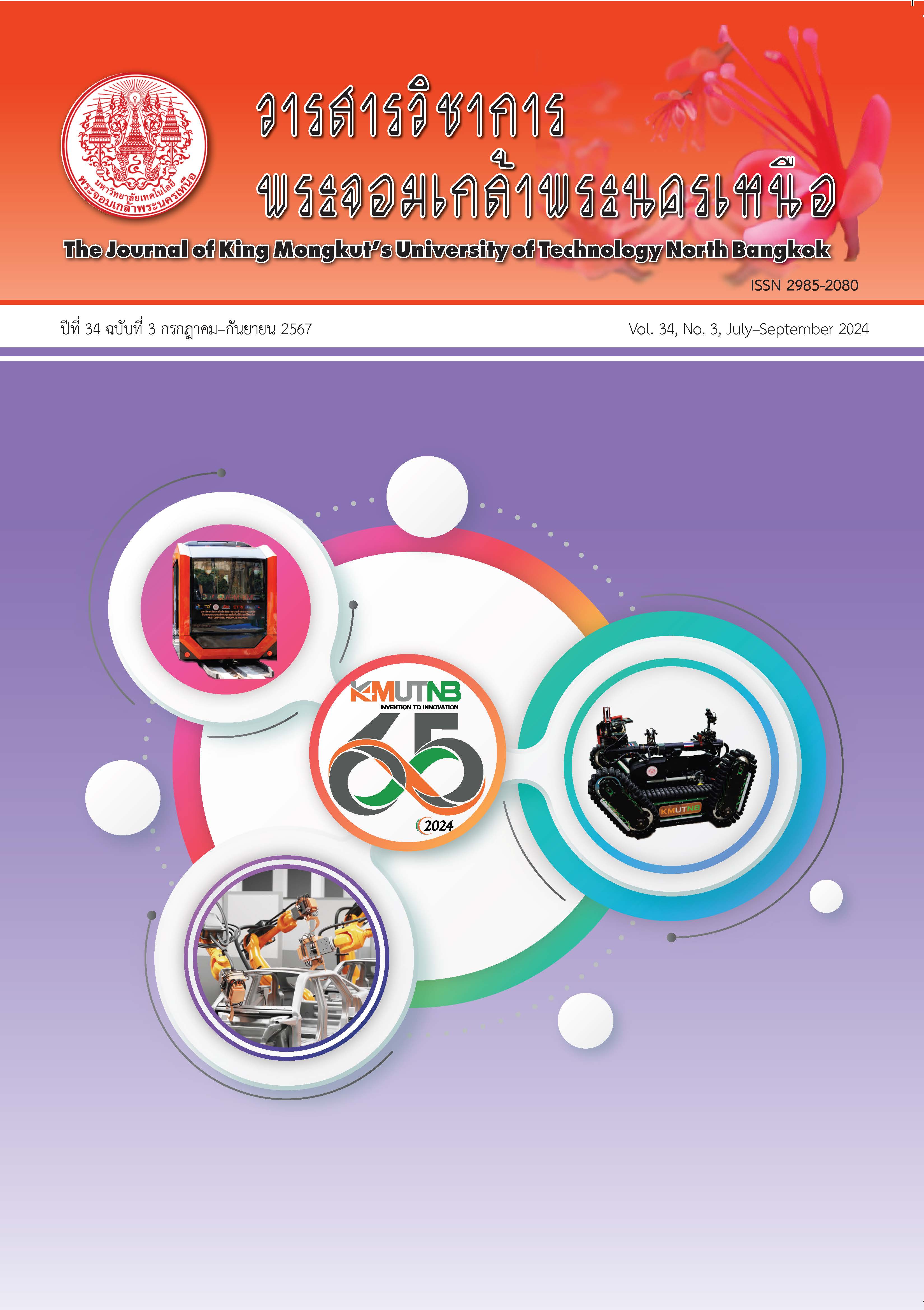ผลของการใช้คลื่นความถี่สูงโดยหลักการให้ความร้อนแบบไดอิเล็กตริกต่อการกำจัดเชื้อแบคทีเรียกลุ่มโคลิฟอร์มและฟีคัลโคลิฟอร์มในน้ำอ้อยคั้นสด
Main Article Content
บทคัดย่อ
อ้อยเป็นพืชเศรษฐกิจนอกจากจะแปรรูปเป็นน้ำตาลแล้ว ยังสามารถแปรรูปเป็นเครื่องดื่มน้ำอ้อยคั้นสด สามารถทำได้ง่ายมีขายทั่วไปตามตลาดท้องถิ่น ความปลอดภัยจากเชื้อแบคทีเรียที่เป็นอันตรายต่อผู้บริโภคเป็นสิ่งสำคัญ หากปะปนมากับเครื่องดื่มสามารถก่อให้เกิดโรคต่างๆ ได้ ในงานวิจัยนี้นำเสนอผลของการศึกษาการกำจัดเชื้อแบคทีเรียกลุ่มโคลิฟอร์มและฟีคัลโคลิฟอร์มด้วยคลื่นความถี่สูงโดยหลักการให้ความร้อนแบบไดอิเล็กตริกในน้ำอ้อยคั้นสด ซึ่งตัวอย่างที่ถูกนำมาศึกษาจะถูกผสมเชื้อแบคทีเรียลงไป ก่อนนำไปผ่านคลื่นความถี่สูง 800 วัตต์ เป็นเวลา 1 นาที และ 1 นาที 30 วินาที ที่ปริมาตร 100 มิลลิลิตร จากนั้นเก็บรักษาไว้ที่อุณหภูมิ 4 องศาเซลเซียส 1 คืน ก่อนนำไปตรวจสอบปริมาณเชื้อแบคทีเรียกลุ่มโคลิฟอร์มและฟีคัลโคลิฟอร์มที่มีอยู่ในตัวอย่างด้วยวิธีมาตรฐานสำหรับการตรวจสอบน้ำและน้ำเสีย นอกจากนี้คุณสมบัติไดอิเล็กตริก ความเป็นกรด-ด่าง และปริมาณน้ำตาลในของเหลวจะถูกตรวจสอบด้วย เชื้อแบคทีเรียสามารถถูกกำจัดได้ด้วยการให้ความร้อนโดยคลื่นความถี่สูง แต่คุณสมบัติไดอิเล็กตริก ความเป็นกรด-ด่าง และปริมาณน้ำตาลของน้ำอ้อยไม่เปลี่ยนแปลงอย่างมีนัยสำคัญ
Article Details

อนุญาตภายใต้เงื่อนไข Creative Commons Attribution-NonCommercial-NoDerivatives 4.0 International License.
บทความที่ลงตีพิมพ์เป็นข้อคิดเห็นของผู้เขียนเท่านั้น
ผู้เขียนจะต้องเป็นผู้รับผิดชอบต่อผลทางกฎหมายใดๆ ที่อาจเกิดขึ้นจากบทความนั้น
เอกสารอ้างอิง
S. Arif, A. Batool, W. Nazir, R. S. Khan, and N. Khalid, “Physiochemical characteristics nutritional properties and health benefits of sugarcane juice,” in Non-alcoholic Beverages: Volume 6. The Science of Beverages, 2019, pp. 227–257.
P. M. S. Homthong, “Detection of coliform bacteria and Escherichia coli in sugar cane juice at Amphur Muang Chonburi, Chonburi province,” The Golden Teak : Science and Technology Journal, vol. 2, pp. 8, 2019 (in Thai).
C. Ambrosi, M. Sarshar, M. R. Aprea, A. Pompilio, G. D. Bonaventura, F. Strati, A. Pronio, M. Nicoletti, C. Zagaglia, A. T. Palamara. and D. Scribano, “Colonic adenoma-associated Escherichia coli express specific phenotypes,” Microbes and Infection, vol. 21, no. 7, pp. 305–312, 2019.
R. Nag, S. Nolan, V. O'Flaherty, O. Fenton, K. G. Richards, B. K. Markey, P. Whyte, D. Bolton, and E. Cummins, “Quantitative microbial human exposure model for faecal indicator bacteria and risk assessment of pathogenic Escherichia coli in surface runoff following application of dairy cattle slurry and co-digestate to grassland,” Journal of Environmental Management, vol. 299, 2021.
J. Vila, E. Sáez-López, J. R. Johnson, U. Römling, U. Dobrindt, R. Cantón, C. G. Giske, T. Naas, A. Carattoli, M. Martínez-Medina, J. Bosch, P. Retamar, J. Rodríguez-Baño, F. Baquero, and S. M. Soto, “Escherichia coli: An old friend with new tidings,” FEMS Microbiology Reviews, vol. 40, no. 4, pp. 437–463.
P. R. Meena, P. Yadav, H. Hemlata, K. K. Tejavath, and A. P. Singh, “Poultry-origin extraintestinal Escherichia coli strains carrying the traits associated with urinary tract infection, sepsis, meningitis and avian colibacillosis in India,” Journal of Applied Microbiology, vol. 130, no. 6, pp. 2087–2101, 2021.
N. Zlatkov and B. E. Uhlin, “Absence of global stress regulation in Escherichia coli promotes pathoadaptation and novel c-di-GMP-dependent metabolic capability,” Scientific Reports, vol. 9, no. 1, 2019.
R. Zhang, C. Song, M. Kou, P. Yin, X. Jin, L. Wang, Y. Deng, B. Wang, D. Xia, P. K. Wong, and L. Ye, “Sterilization of Escherichia coli by photothermal synergy of WO3–x/C nanosheet under infrared light irradiation,” Environmental Science & Technology, vol. 54, no. 6, pp. 3691–3701, 2020.
Z. O. Nazar and N. O. A. Al-Musawi, “Performance application of ultraviolet disinfection technique for raw water,” Journal of Physics: Conference Series, vol. 1895, no. 1, pp. 1–12, 2021.
P. Intra, A. Yawootti, V. Asanavijit, P. Manopian, C. Pengmanee, and N. Somsri, “Inactivation of E. coli in milk tea undergoing pulsed electric field pasteurization,” The Journal of KMUTNB, vol. 25, no. 3, pp. 425–437, 2015 (in Thai).
J. D. Dubreuil, “Fruit extracts to control pathogenic Escherichia coli: A sweet solution,” Heliyon, vol. 6, no. 2, 2020.
S. Adulvitayakorn, S. H. Azhari, and H. Hasan, “The effects of conventional thermal, microwave heating, and thermosonication treatments on the quality of sugarcane juice,” Journal of Food Processing and Preservation, vol. 44, no. 2, 2020.
S. Zia, M. R. Khan, X. A. Zeng, Sehrish, M. A. Shabbir, and R. M. Aadil, “Combined effect of microwave and ultrasonication treatments on the quality and stability of sugarcane juice during cold storage,” International Journal of Food Science and Technology, vol. 54, no. 8, pp. 2563–2569, 2019.
O. P. Chauhan, N. Ravi, N. Roopa, S. Kumar, and P. S. Raju, “High pressure, temperature and time-dependent effects on enzymatic and microbial properties of fresh sugarcane juice,” Journal of Food Science and Technology, vol. 54, no. 12, pp. 4135–4138, 2017.
B. Brochier, G. D. Mercali, and L. D. F. Marczak, “Effect of moderate electric field on peroxidase activity, phenolic compounds and color during ohmic heating of sugarcane juice,” Journal of Food Processing and Preservation, vol. 43, no. 12, 2019.
Y. A. Gezahegn, J. Tang, S. S. Sablani, P. D. Pedrow, Y.-Ki Hong, H. Lin, and Z. Tang, “Dielectric properties of water relevant to microwave assisted thermal pasteurization and sterilization of packaged foods,” Innovative Food Science & Emerging Technologies, vol. 74, 2021.
S. Peng, J. Hummerjohann, R. Stephan, and P. Hammer, “Short communication: Heat resistance of Escherichia coli strains in raw milk at different subpasteurization conditions,” Journal of Dairy Science, vol. 96, no. 6, pp. 3543–3546, 2013.

